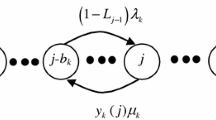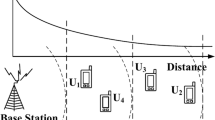Abstract
Traditional definitions of capacity of CDMA networks are either related to the number of calls they can handle (pole capacity) or to the arrival rate that guarantees that the rejection rate (or outage) is below a given fraction (Erlang capacity). We extend the latter definition to other quality of service (QoS). We consider best-effort (BE) traffic sharing the network resources with real-time (RT) applications. As is often the case in CDMA systems, we assume that the BE traffic access is done using a time-shared channel (such as the HDR or the HSDPA). BE applications can adapt their instantaneous transmission rate to the available one and thus need not be subject to admission control or outages. Their meaningful QoS is the average delay (i.e. the sojourn time). The delay aware capacity is then defined as the arrival rate of BE calls that the system can handle such that their expected delay is bounded by a given constant. We compute in this paper both the blocking probability of the RT traffic having an adaptive Grade of Service (GoS) as well as the expected delay of the BE traffic for an uplink multicell WCDMA system. This yields the Erlang capacity for former and the delay capacity for the latter.
Similar content being viewed by others
References
N. Akar and K. Sohraby, Finite and infinite QBD chains: A simple and unifying algorithmic approach, in: Proceedings of IEEE Infocom (April 1997) pp. 1105–1113.
E. Altman, Capacity of multi-service CDMA cellular networks with transmission-rate control: A queueing analysis, in: Proceedings of ACM Mobicom (Sept. 2002) pp. 205–214.
E. Altman, D. Artiges and K. Traore, On the integration of best-effort and guaranteed performance services, European Transactions on Telecommunications 10(2) (March–April 1999) 125–134.
P. Bender, P. Black, M. Grob, R. Padovani, N. Sindhushayana and A. Viterbi, CDMA/HDR: A bandwidth-efficient high-speed wireless data service for nomadic users, IEEE Communications Magazine 38(7) (July 2000) 70–77.
V. De Nitto Personé and V. Grassi, Solution of finite QBD processes, Journal of Applied Probability 33 (1996) 1003–1010.
F. Delcoigne, A. Proutiére and G. Régnié, Modelling integration of streaming and data traffic, Performance Evaluation 55(2–4) (February 2004) 185–209.
D.P. Gaver, P. Jacobs and G. Latouche, Finite birth and death models in randomly changing environments, Advances in Applied Probability 16 (1984) 715–731.
B. Hajek, Birth-and-death processes on the integers with phases and general boundaries, Journal of Applied Probability 19 (1982) 488–499.
H. Holma and A. Toskala (Ed), WCDMA for UMTS, Radio Access For Third Generation Mobile Communications (John Wiley & Sons, Ltd., 2001).
I. Koo, J. Ahn, J.-A. Lee and K. Kim, Analysis of erlang capacity for the multimedia DS-CDMA systems, IEICE Transactions of Fundamentals E82-A(5) (May 1999) 849–855.
J. Laiho and A. Wacker, Radio network planning process and methods for WCDMA, Annales des Télécommunications 56(5–6) (2001) 317–331.
R. Leelahakriengkrai and R. Agrawal, Scheduling in multimedia CDMA wireless networks, Technical Report ECE-99-3, ECE Dept., University of Wisconsin-Madison (July 1999).
N. Mandayam, J. Holtzman and S. Barberis, Performance and capacity of a voice/data CDMA system with variable bit rate sources, in: Special Issue on Insights into Mobile Multimedia Communications (Academic Press Inc., January 1997).
V. Naoumov, Matrix-multiplicative approach to quasi-birth-and-death processes analysis, in: Matrix-Analytic Methods in Stochastic Models – Lecture Notes in Pure and Applied Mathematics (1996) pp. 87–106.
M. Neuts, Matrix-Geometric Solutions in Stochastic Models: An Algorithmic Approach (The John Hopkins Unversity Press, 1981).
R. Núñez Queija and O.J. Boxma, Analysis of a multi-server queueing model of ABR, Journal of Applied Mathematics and Stochastic Analysis 11(3) (1998) 339–354.
S. Parkvall, E. Dahlman, P. Frenger, P. Beming and M. Persson, The high speed packet eata evolution of WCDMA, in: Proceedings of the 12th IEEE PIMRC (October 2001) G 27–G 31.
S. Ramakrishna and J.M. Holtzman, A scheme for throughput maximization in a dual-class CDMA system, IEEE Journal Selected Areas in Commumications 16(6) (August 1998) 830–844.
J. Roberts and L. Massoulié, Bandwidth sharing and elastic control for elastic traffic, in: Proceedings of ITC Specialists Seminar, Yokohama (October 1998).
A.M. Viterbi and A.J. Viterbi, Erlang capacity of a power controlled CDMA system, IEEE Journal on Selected Areas in Communications 11(6) (August 1993) 892–900.
Q. Wu, W.-L. Wu and J.-P. Zhou, Effects of slow fading SIR errors on CDMA capacity, in: Proceedings of IEEE VTC (May 1997) pp. 2215–17.
Author information
Authors and Affiliations
Corresponding author
Additional information
A shorter version of this work was presented at the IEEE WCNC 2003 in New Orleans, LA, USA.
Nidhi Hegde received the B.Sc. degree with specialization in Biochemistry (1995) from the University of Alberta, Canada, and the M.Sc (1997) in Computer Science and the Ph.D (2000) degree in Telecommunications and Computer Networking, both at the University of Missouri-Kansas City, USA. She has been with France Telecom R&D since January 2005. Her research interests include performance evaluation of networks, with an emphasis on wireless networks.
E. Altman received the B.Sc. degree in electrical engineering (1984), the B.A. degree in physics (1984) and the Ph.D. degree in electrical engineering (1990), all from the Technion-Israel Institute, Haifa. In (1990) he further received his B.Mus. degree in music composition in Tel-Aviv university. Since 1990, he has been with INRIA (National research institute in informatics and control) in Sophia-Antipolis, France. His current research interests include performance evaluation and control of telecommunication networks and in particular congestion control, wireless communications and networking games. He is in the editorial board of several scientific journals: Stochastic Models, JEDC, COMNET, SIAM SICON and WINET. He has been the (co)chairman of the program committee of several international conferences and workshops (on game theory, networking games and mobile networks). More informaion can be found at http://www.inria.fr/mistral/personnel/Eitan.Altman/me.html
Rights and permissions
About this article
Cite this article
Hegde, N., Altman, E. Capacity of Multiservice WCDMA Networks with Variable GoS. Wireless Netw 12, 241–253 (2006). https://doi.org/10.1007/s11276-005-5272-0
Published:
Issue Date:
DOI: https://doi.org/10.1007/s11276-005-5272-0




